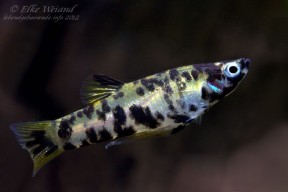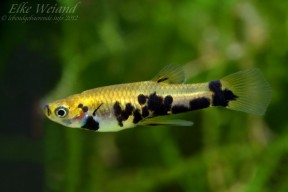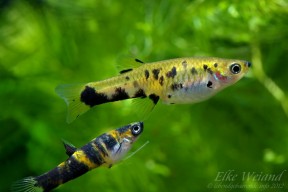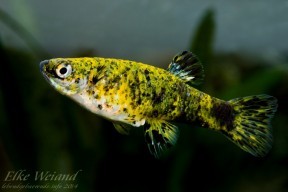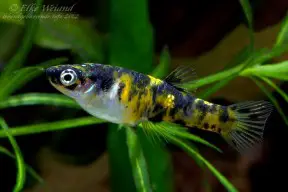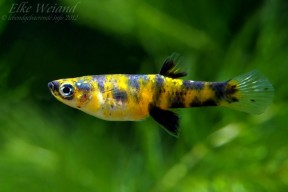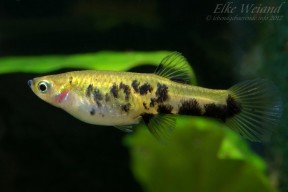Phalloceros caudimaculatus
Dusky Millions Fish
SynonymsTop ↑
Girardinus caudimaculatus Hensel, 1868
Etymology
Phalloceros: from the Ancient Greek ϕαλλός (phallos), meaning ‘penis’, and κέρας (kéras) meaning ‘horn’.
caudimaculatus: from the Latin cauda, meaning ‘tail’, and maculatus, meaning ‘spotted’.
Classification
Order: Cyprinodontiformes Family: Poeciliidae
Distribution
Occurs naturally in Brazil, Paraguay, Uruguay and Argentina with feral populations in Australia, New Zealand, Ethiopia and Malawi which were purportedly introduced for purposes of mosquito control but are now considered invasive.
Following Lucinda (2008) its natural range comprises the Lagoa dos Patos system, lower rio Uruguai, rio Tramandaí, and rio Mampituba in Rio Grande do Sul state, Brazil, plus coastal systems of Uruguay and Argentina.
Type locality is ‘at the Costa da Serra at São Leopoldo in pounds and ditches’, referring to the city of São Leopoldo in Rio Grande do Sul state, southern Brazil.
Habitat
Inhabits sluggish rivers and streams as well as ponds, often with dense vegetation.
Some populations are found in slightly brackish water.
Maximum Standard Length
Male 30 – 35 mm; female 50 – 70 mm.
Aquarium SizeTop ↑
A trio of these can be kept in a 50 litre tank.
Maintenance
A gently filtered, heavily planted set-up suits it best, and it seems to be sensitive to fresh water. Consequently, water changes should be small but frequent.
Water Conditions
Temperature: 16 – 22 °C, is best in an aquarium, though it will survive for short periods in temperatures down to 10°C and up to 30°C. Lower temperatures are handled better than higher.
pH: 7.0 – 8.0
Hardness: 90 – 447 ppm; populations from brackish habitats are less tolerant of soft water.
Diet
Unfussy and omnivorous, it will accept most foods offered. In the wild it grazes algae and eats small insects, insect larvae and crustaceans. Frozen and dry foods are readily accepted in the aquarium.
Behaviour and CompatibilityTop ↑
Should ideally be maintained in a species tank.
Sexual Dimorphism
Males are much smaller than females and possess a prominent gonopodium.
Reproduction
Being a livebearer, it is quite easy to breed. If the parents are well fed and there are densely planted areas in the tank, the fry should be safe with the adult fish.
As the males can be rater persistent in their pursuit of females, having more females than males in the tank is advisable.
The gestation period is 4-6 weeks depending on temperature. The fry will eat microworms and freshly hatched Artemia as soon as they are born.
NotesTop ↑
This species is highly variable in terms of colour pattern.
Three ornamental forms are well known in the aquarium hobby and have been given unofficial ‘scientific’ names which are not italicised here:
1. A spotted form often referred to as Phalloceros caudimaculatus ‘reticulatus’.
2. A golden form often referred to as Phalloceros caudimaculatus ‘auratus’.
3. A spotted golden form often referred to as Phalloceros caudimaculatus ‘reticulatus auratus’.
Both of the golden forms appear to have a poor survival rate under natural conditions.
P. caudimaculatus is the type species of the genus which was monotypic prior to a major review published in 2008 in which 21 new species were described. Among these, it is told apart from P. anisophallos, P. megapolos, P. spiloura, P. reisi, P. buckupi, P. alessandrae, P. lucenorum, P. uai, P. pellos, and P. malabarbai by the female urogenital papilla being located between the anus and base of the first anal-fin ray, along the midline of the body (vs. curved to the right, located laterally; anus in contact with the first anal-fin ray).
It is distinguished from P. tupinamba, P. leptokeras, and P. aspilos by: female urogenital papilla straight along midline (vs. slightly left orientated); absence of a lateral ramus of the female urogenital papilla (vs. presence); absence of a hook in the gonopodial appendix (vs. presence).
It can be told apart from P. enneaktinos, P. titthos, P. elachistos, and P. harpagos by the absence of hooks in both halves of the gonopodial appendix (vs. hook present in both halves), and is distinguished from P. heptaktinos by males possessing 8 dorsal-fin rays (very exceptionally seven) and females seven rays (very exceptionally 8).
It is distinguished from P. ocellatus, P. mikrommatos, and P. leticiae by possessing a non-ocellated, elliptical and vertically elongate lateral spot which is occasionally absent (vs. lateral spot roundish to rounded, well-defined and ocellated).
Thanks for this profile go to Karsten Plesner.
References
- Hensel, R., 1868 - Archiv für Naturgeschichte 34(1): 323-375
Beiträge zur Kenntniss der Wirbelthiere Südbrasiliens. (Fortsetzung). - Dawes, J., 1985 - Blandford: 1-240
Livebearing fishes - A guide to their aquarium care, biology and classification. - Gärtner, G., 1981 - Verlag Eugen Ulmer: 1-152
Zahnkarpfen - Die lebendgebärenden Im Aquarium. - Lucinda, P. H. F., 2008 - Neotropical Ichthyology 6(2): 113-158
Systematics and biogeography of the genus Phalloceros Eigenmann, 1907 (Cyprinodontiformes: Poeciliidae: Poeciliinae), with the description of twenty-one new species. - Wischnath, L., 1993 - T.F.H. Publications, Inc., United States of America: 1-336
Atlas of livebearers of the world.
